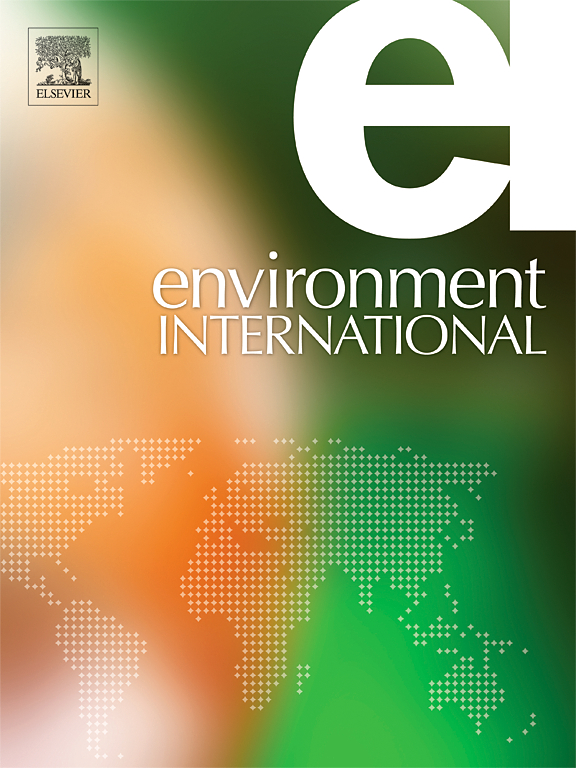MGE-associated ARGs exhibit higher expression efficiency than chromosomal non-MGE loci and predominantly contribute to resistance expression in pig farm wastewater
IF 9.7
1区 环境科学与生态学
Q1 ENVIRONMENTAL SCIENCES
引用次数: 0
Abstract
Antibiotic resistance (AMR) in animal agriculture represents a critical One Health challenge, with pig farms serving as major reservoirs for antibiotic resistance genes (ARGs) and mobile genetic elements (MGEs). While MGEs are known drivers of ARG dissemination, their impact on actual expression of resistance in these complex microbial communities is poorly understood. This study aimed to quantify the contribution of MGE-associated ARGs to overall resistance expression and compare their transcriptional efficiency to chromosomally located ARGs in pig farm wastewater. Utilizing deep metagenomic and metatranscriptomic sequencing on wastewater from five typical Chinese pig farms, we comprehensively elucidated ARG presence, genetic context, host association, and transcriptional activity. We identified a vast dataset comprising 811 ARG types conferring resistance to 27 antibiotic classes, with 71.02 % actively transcribed, indicating significant resistance potential. MGEs were associated with 34.87 % of ARG-like ORFs. Crucially, MGE-associated ARGs were responsible for the majority (62.07 %) of total ARG transcript abundance, exhibiting an expression efficiency nearly 2.5 times higher than ARGs on chromosomal non-MGE loci. Taxonomic analysis revealed that these highly expressed MGE-associated ARGs were primarily hosted by genera known to include opportunistic pathogens, such as Enterococcus, Escherichia, and Klebsiella. Differential coverage binning further uncovered diverse draft genomes simultaneously harboring multiple highly expressed ARGs and MGEs, potentially contributing to the persistence and spread of highly resistant bacterial strains. Our findings underscore that MGEs not only propagate ARGs but critically enhance their expression, providing vital data for effective AMR surveillance and mitigation strategies within the One Health framework.
与非mge基因座相比,mge相关的ARGs具有更高的表达效率,并且在猪场废水中主要参与抗性表达
动物农业中的抗生素耐药性(AMR)是一个关键的“同一个健康”挑战,猪场是抗生素耐药性基因(ARGs)和移动遗传元件(MGEs)的主要储存库。虽然已知MGEs是ARG传播的驱动因素,但它们对这些复杂微生物群落中实际耐药性表达的影响知之甚少。本研究旨在量化mge相关ARGs对整体抗性表达的贡献,并比较其在猪场废水中与染色体定位ARGs的转录效率。通过对中国5个典型猪场废水进行深度宏基因组和亚转录组测序,我们全面阐明了ARG的存在、遗传背景、宿主关联和转录活性。我们确定了一个庞大的数据集,包括811种ARG类型,对27种抗生素具有耐药性,其中71.02 %转录活跃,表明具有显著的耐药潜力。MGEs与34.87 %的arg样orf相关。至关重要的是,mge相关的ARGs占总ARG转录物丰度的大部分(62.07 %),其表达效率比染色体非mge位点上的ARGs高近2.5倍。分类学分析显示,这些高表达的mge相关ARGs主要由已知的机会致病菌属(如肠球菌、埃希氏菌和克雷伯氏菌)宿主。差异覆盖结合进一步揭示了多种草案基因组同时包含多个高表达的ARGs和MGEs,这可能有助于高耐药菌株的持续存在和传播。我们的研究结果强调,MGEs不仅传播arg,而且显著增强其表达,为“同一个健康”框架内有效的抗菌素耐药性监测和缓解策略提供了重要数据。
本文章由计算机程序翻译,如有差异,请以英文原文为准。
求助全文
约1分钟内获得全文
求助全文
来源期刊

Environment International
环境科学-环境科学
CiteScore
21.90
自引率
3.40%
发文量
734
审稿时长
2.8 months
期刊介绍:
Environmental Health publishes manuscripts focusing on critical aspects of environmental and occupational medicine, including studies in toxicology and epidemiology, to illuminate the human health implications of exposure to environmental hazards. The journal adopts an open-access model and practices open peer review.
It caters to scientists and practitioners across all environmental science domains, directly or indirectly impacting human health and well-being. With a commitment to enhancing the prevention of environmentally-related health risks, Environmental Health serves as a public health journal for the community and scientists engaged in matters of public health significance concerning the environment.
 求助内容:
求助内容: 应助结果提醒方式:
应助结果提醒方式:


